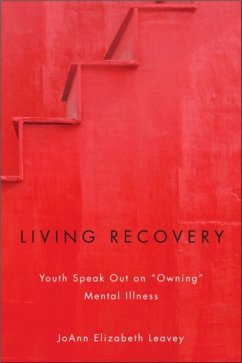- Broschiertes Buch
- Merkliste
- Auf die Merkliste
- Bewerten Bewerten
- Teilen
- Produkt teilen
- Produkterinnerung
- Produkterinnerung
Living Recovery takes readers through the journey of ELAR (emergence, loss, adaptation and recovery) of interviewed youth living with mental health problems. The book shows us that youth do in fact adapt, recover, and reintegrate over time.
Andere Kunden interessierten sich auch für
![Right to Die Versus Sacredness of Life Right to Die Versus Sacredness of Life]() Kalman KaplanRight to Die Versus Sacredness of Life114,99 €
Kalman KaplanRight to Die Versus Sacredness of Life114,99 €![Committed to the Sane Asylum Committed to the Sane Asylum]() Susan SchellenbergCommitted to the Sane Asylum45,99 €
Susan SchellenbergCommitted to the Sane Asylum45,99 €![The Complete Guide to Creating a Special Needs Life Plan The Complete Guide to Creating a Special Needs Life Plan]() Hal WrightThe Complete Guide to Creating a Special Needs Life Plan39,99 €
Hal WrightThe Complete Guide to Creating a Special Needs Life Plan39,99 €![Psychological Perspectives on Deafness Psychological Perspectives on Deafness]() Psychological Perspectives on Deafness82,99 €
Psychological Perspectives on Deafness82,99 €![Young Adults with Special Needs Young Adults with Special Needs]() John FrielYoung Adults with Special Needs45,99 €
John FrielYoung Adults with Special Needs45,99 €![Handbook of Social Work with Groups Handbook of Social Work with Groups]() Handbook of Social Work with Groups86,99 €
Handbook of Social Work with Groups86,99 €![Aging and Disabilities Aging and Disabilities]() James CallahanAging and Disabilities114,99 €
James CallahanAging and Disabilities114,99 €-
-
Living Recovery takes readers through the journey of ELAR (emergence, loss, adaptation and recovery) of interviewed youth living with mental health problems. The book shows us that youth do in fact adapt, recover, and reintegrate over time.
Hinweis: Dieser Artikel kann nur an eine deutsche Lieferadresse ausgeliefert werden.
Hinweis: Dieser Artikel kann nur an eine deutsche Lieferadresse ausgeliefert werden.
Produktdetails
- Produktdetails
- Verlag: Wilfrid Laurier University Press
- Seitenzahl: 165
- Erscheinungstermin: 26. Februar 2015
- Englisch
- Abmessung: 224mm x 150mm x 15mm
- Gewicht: 318g
- ISBN-13: 9781554589173
- ISBN-10: 1554589177
- Artikelnr.: 36957312
- Herstellerkennzeichnung
- Libri GmbH
- Europaallee 1
- 36244 Bad Hersfeld
- gpsr@libri.de
- Verlag: Wilfrid Laurier University Press
- Seitenzahl: 165
- Erscheinungstermin: 26. Februar 2015
- Englisch
- Abmessung: 224mm x 150mm x 15mm
- Gewicht: 318g
- ISBN-13: 9781554589173
- ISBN-10: 1554589177
- Artikelnr.: 36957312
- Herstellerkennzeichnung
- Libri GmbH
- Europaallee 1
- 36244 Bad Hersfeld
- gpsr@libri.de
Dr. JoAnn Leavey is a registered psychologist and registered nurse, writer, poet, musician, pilot, and life enthusiast who has lived and worked in Vancouver, London, and Toronto. She has spoken in over eleven countries, motivating and teaching people how to help youth and others living with mental health problems. She publishes regularly in Academy Forum, a journal of The American Academy of Psychoanalysis and Dynamic Psychiatry. In 2015 Dr. Leavey received the Governor General's Caring Canadian Award for her local and international medical, public and mental health, and environmental volunteer work.
Table of Contents for
Living Recovery: Youth Speak Out on âEURoeOwningâEUR? Mental Illness by
JoAnn Elizabeth Leavey
Acknowledgements
Chapter One: Framing the Context for Youth with Mental Illness
Introduction
Terms Used in This Book
Who Is This Book For?
Redefining Our Understanding of Mental "Illness"
The Journey of Youth Through the Mental Health System
Framing the Context for Youth Living with Mental Illness
The Effects of a Mental Illness Diagnosis on Youth
Youth, Metaphor, and Mental Illness
Youth and the Social Construction of Mental Illness
The Significance and Direction of This Work
Summary
Chapter Two: How Do Youth Experience Mental Illness?
Prevalence of Mental Illness
Growing Up: Forming Identity and Developmental Tasks for Young People
Some Common Problems Experienced by Youth with Mental Illness
Summary
Chapter Three: Youth Participants: Who Are They?
Research Objectives
Why Use Qualitative Research?
The Interviews
Demographic Profile of Participants
My Impressions of Participants
Summary
Chapter Four: Youth Speak: Mental Health Experiences and Needs
Data Analysis: Emergency, Loss, Adaptation, and Recovery (ELAR)
What Do Youth Have to Say?
1. Emergence
2. Loss
3. Adaptation
4. Recovery
Summary
Chapter Five: Understanding: Integrating the Results
Integrating the Results and the Stages of Emergence, Loss, Adaptation, and
Recovery
General Context
Developing Theory about Youth and Mental Illness: A Framework for
Understanding
Considerations for Practice
The Stages of Emergence, Loss, Adaptation, and Recovery
Integration and Implications of Key Findings
Summary
Chapter Six: Where Are We and Where Do We Go from Here?
Gap in Service Delivery
Significance of Early Intervention
Implications and Suggestions for Testing the Theoretical Framework
Adaptation: A Conceptual Approach
Recovery and Wellness
Implications and Suggestions for Future Program and Policy Design
Limits and Benefits of This Research
Suggestions for Future Research
Conclusion
Appendix
References
Index
Living Recovery: Youth Speak Out on âEURoeOwningâEUR? Mental Illness by
JoAnn Elizabeth Leavey
Acknowledgements
Chapter One: Framing the Context for Youth with Mental Illness
Introduction
Terms Used in This Book
Who Is This Book For?
Redefining Our Understanding of Mental "Illness"
The Journey of Youth Through the Mental Health System
Framing the Context for Youth Living with Mental Illness
The Effects of a Mental Illness Diagnosis on Youth
Youth, Metaphor, and Mental Illness
Youth and the Social Construction of Mental Illness
The Significance and Direction of This Work
Summary
Chapter Two: How Do Youth Experience Mental Illness?
Prevalence of Mental Illness
Growing Up: Forming Identity and Developmental Tasks for Young People
Some Common Problems Experienced by Youth with Mental Illness
Summary
Chapter Three: Youth Participants: Who Are They?
Research Objectives
Why Use Qualitative Research?
The Interviews
Demographic Profile of Participants
My Impressions of Participants
Summary
Chapter Four: Youth Speak: Mental Health Experiences and Needs
Data Analysis: Emergency, Loss, Adaptation, and Recovery (ELAR)
What Do Youth Have to Say?
1. Emergence
2. Loss
3. Adaptation
4. Recovery
Summary
Chapter Five: Understanding: Integrating the Results
Integrating the Results and the Stages of Emergence, Loss, Adaptation, and
Recovery
General Context
Developing Theory about Youth and Mental Illness: A Framework for
Understanding
Considerations for Practice
The Stages of Emergence, Loss, Adaptation, and Recovery
Integration and Implications of Key Findings
Summary
Chapter Six: Where Are We and Where Do We Go from Here?
Gap in Service Delivery
Significance of Early Intervention
Implications and Suggestions for Testing the Theoretical Framework
Adaptation: A Conceptual Approach
Recovery and Wellness
Implications and Suggestions for Future Program and Policy Design
Limits and Benefits of This Research
Suggestions for Future Research
Conclusion
Appendix
References
Index
Table of Contents for
Living Recovery: Youth Speak Out on âEURoeOwningâEUR? Mental Illness by
JoAnn Elizabeth Leavey
Acknowledgements
Chapter One: Framing the Context for Youth with Mental Illness
Introduction
Terms Used in This Book
Who Is This Book For?
Redefining Our Understanding of Mental "Illness"
The Journey of Youth Through the Mental Health System
Framing the Context for Youth Living with Mental Illness
The Effects of a Mental Illness Diagnosis on Youth
Youth, Metaphor, and Mental Illness
Youth and the Social Construction of Mental Illness
The Significance and Direction of This Work
Summary
Chapter Two: How Do Youth Experience Mental Illness?
Prevalence of Mental Illness
Growing Up: Forming Identity and Developmental Tasks for Young People
Some Common Problems Experienced by Youth with Mental Illness
Summary
Chapter Three: Youth Participants: Who Are They?
Research Objectives
Why Use Qualitative Research?
The Interviews
Demographic Profile of Participants
My Impressions of Participants
Summary
Chapter Four: Youth Speak: Mental Health Experiences and Needs
Data Analysis: Emergency, Loss, Adaptation, and Recovery (ELAR)
What Do Youth Have to Say?
1. Emergence
2. Loss
3. Adaptation
4. Recovery
Summary
Chapter Five: Understanding: Integrating the Results
Integrating the Results and the Stages of Emergence, Loss, Adaptation, and
Recovery
General Context
Developing Theory about Youth and Mental Illness: A Framework for
Understanding
Considerations for Practice
The Stages of Emergence, Loss, Adaptation, and Recovery
Integration and Implications of Key Findings
Summary
Chapter Six: Where Are We and Where Do We Go from Here?
Gap in Service Delivery
Significance of Early Intervention
Implications and Suggestions for Testing the Theoretical Framework
Adaptation: A Conceptual Approach
Recovery and Wellness
Implications and Suggestions for Future Program and Policy Design
Limits and Benefits of This Research
Suggestions for Future Research
Conclusion
Appendix
References
Index
Living Recovery: Youth Speak Out on âEURoeOwningâEUR? Mental Illness by
JoAnn Elizabeth Leavey
Acknowledgements
Chapter One: Framing the Context for Youth with Mental Illness
Introduction
Terms Used in This Book
Who Is This Book For?
Redefining Our Understanding of Mental "Illness"
The Journey of Youth Through the Mental Health System
Framing the Context for Youth Living with Mental Illness
The Effects of a Mental Illness Diagnosis on Youth
Youth, Metaphor, and Mental Illness
Youth and the Social Construction of Mental Illness
The Significance and Direction of This Work
Summary
Chapter Two: How Do Youth Experience Mental Illness?
Prevalence of Mental Illness
Growing Up: Forming Identity and Developmental Tasks for Young People
Some Common Problems Experienced by Youth with Mental Illness
Summary
Chapter Three: Youth Participants: Who Are They?
Research Objectives
Why Use Qualitative Research?
The Interviews
Demographic Profile of Participants
My Impressions of Participants
Summary
Chapter Four: Youth Speak: Mental Health Experiences and Needs
Data Analysis: Emergency, Loss, Adaptation, and Recovery (ELAR)
What Do Youth Have to Say?
1. Emergence
2. Loss
3. Adaptation
4. Recovery
Summary
Chapter Five: Understanding: Integrating the Results
Integrating the Results and the Stages of Emergence, Loss, Adaptation, and
Recovery
General Context
Developing Theory about Youth and Mental Illness: A Framework for
Understanding
Considerations for Practice
The Stages of Emergence, Loss, Adaptation, and Recovery
Integration and Implications of Key Findings
Summary
Chapter Six: Where Are We and Where Do We Go from Here?
Gap in Service Delivery
Significance of Early Intervention
Implications and Suggestions for Testing the Theoretical Framework
Adaptation: A Conceptual Approach
Recovery and Wellness
Implications and Suggestions for Future Program and Policy Design
Limits and Benefits of This Research
Suggestions for Future Research
Conclusion
Appendix
References
Index








